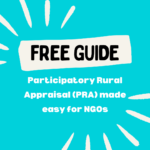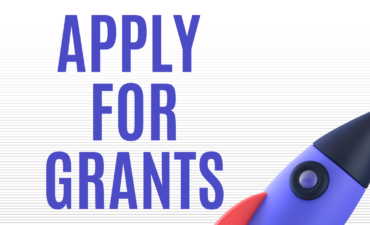Introduction: Participatory Rural Appraisal (PRA) made easy for NGOs (Free Guide). Participatory Rural Appraisal (PRA) is a community-based approach to gather and analyze information, insights, and knowledge from the members of rural communities. It is a collaborative and participatory methodology that empowers community members to actively contribute to the assessment and planning processes. Unlike traditional top-down approaches, PRA recognizes the local community as a valuable source of expertise and promotes their involvement in decision-making.
In PRA, the focus is on engaging community members in a dialogue, utilizing their firsthand experiences and indigenous knowledge to identify challenges, resources, and potential solutions. This approach fosters a sense of ownership and empowerment among community members, making them active participants rather than passive recipients of development initiatives.
Importance of Participatory Rural Appraisal (PRA) for NGOs working in rural areas
Why is it important to conduct a Participatory Rural Appraisal (PRA) for NGOs in the first place, if you are working NGO in rural areas then you must find out why you should conduct PRA religiously?
- Facilitate Community Empowerment: PRA empowers local communities by involving them in decision-making processes, fostering a sense of ownership and responsibility for development initiatives.
- Enhance Local Knowledge: PRA leverages the rich indigenous knowledge of rural communities, ensuring a more accurate and holistic understanding of local challenges, resources, and potential solutions.
- Promote Inclusivity: PRA ensures the inclusion of diverse community perspectives, including those of marginalized groups, leading to more equitable and sustainable development outcomes.
- Improve Project Relevance: By actively involving community members, NGOs can tailor their projects to the specific needs, priorities, and cultural contexts of the target communities, enhancing the relevance and effectiveness of interventions.
- Build Trust and Collaboration: PRA establishes trust between NGOs and communities through transparent and participatory processes, fostering collaborative relationships that are crucial for successful and sustainable development efforts.
- Enable Contextual Problem-Solving: PRA allows NGOs to identify and address issues in the local context, promoting solutions that are culturally sensitive, environmentally sustainable, and aligned with community values.
- Optimize Resource Allocation: By understanding the community’s resources and challenges through PRA, NGOs can allocate resources more efficiently, maximizing the impact of their interventions.
- Enhance Monitoring and Evaluation: PRA facilitates ongoing community engagement, enabling NGOs to continuously monitor and evaluate project progress, adapt strategies, and address emerging issues effectively.
In essence, PRA serves as a tool for NGOs to create more responsive, community-driven, and sustainable development initiatives in rural areas, ensuring that interventions are not only well-informed but also capable of fostering positive and lasting change.
Overview of the guide, how this guide can help you understand the basic concept of Participatory Rural Appraisal (PRA)
The guide on Participatory Rural Appraisal (PRA) for NGOs offers a concise yet comprehensive resource. It outlines the principles and steps of PRA, emphasizing its importance in empowering communities, leveraging local knowledge, and enhancing project relevance. The guide aims to assist NGOs in effectively implementing PRA in rural areas, fostering inclusive and sustainable development.
Understanding Participatory Rural Appraisal (PRA)
- Definition and key principles
Participatory Rural Appraisal (PRA) is a community-based approach that involves active collaboration with local residents to assess and address development issues. Key principles include community empowerment, inclusivity, and the utilization of local knowledge for holistic problem-solving.
2. Objectives and benefits for NGOs
Objectives of Participatory Rural Appraisal (PRA) for NGOs:
- Community Empowerment: Facilitate active community involvement in decision-making processes related to development initiatives.
- Inclusive Participation: Ensure the inclusion of diverse perspectives, particularly those of marginalized groups, in planning and implementation.
- Local Knowledge Utilization: Harness the indigenous knowledge of communities to enhance the accuracy and relevance of development interventions.
- Sustainable Solutions: Foster the development of solutions that are culturally sensitive, environmentally sustainable, and aligned with community values.
Benefits for NGOs:
- Improved Project Relevance: Tailor projects to the specific needs and priorities of the community, increasing the impact and effectiveness of interventions.
- Enhanced Community Relations: Build trust and collaborative relationships by involving communities in decision-making, leading to more successful and sustainable outcomes.
- Optimized Resource Allocation: Efficiently allocate resources based on a thorough understanding of community resources and challenges identified through PRA.
- Increased Accountability: Promote transparency and accountability in development efforts by engaging communities in ongoing monitoring and evaluation processes.
In summary, the objectives and benefits of PRA for NGOs revolve around fostering community-driven, contextually relevant, and sustainable development initiatives.
How PRA differs from traditional assessment methods
Participatory Rural Appraisal (PRA) differs from traditional assessment methods in the following ways:
- Bottom-Up Approach: PRA is community-driven, emphasizing active participation of local residents in identifying and addressing development issues. Traditional methods often follow a top-down approach with limited community involvement.
- Inclusive Decision-Making: PRA prioritizes inclusivity by involving diverse community members, including marginalized groups, in decision-making processes. Traditional assessments may rely on a limited set of stakeholders or experts.
- Utilization of Indigenous Knowledge: PRA values and incorporates local knowledge, traditions, and perspectives, recognizing the community as experts in their own context. Traditional methods may overlook or underutilize indigenous knowledge.
- Flexible and Adaptive: PRA is adaptable to diverse cultural contexts and can be customized based on the specific needs of each community. Traditional assessments may follow rigid methodologies that do not easily accommodate local variations.
- Qualitative and Visual Tools: PRA often employs qualitative data collection methods and visual tools, such as maps and diagrams, to enhance communication and understanding. Traditional assessments may rely more heavily on quantitative data and standardized surveys.
- Empowerment of Communities: PRA empowers communities by actively involving them in the entire assessment process, fostering a sense of ownership. Traditional methods may treat communities more as passive recipients of interventions.
- Holistic Understanding: PRA provides a holistic understanding of community dynamics by considering social, economic, environmental, and cultural aspects. Traditional assessments may focus on specific sectors or issues in isolation.
In essence, PRA stands out for its participatory, inclusive, and flexible nature, ensuring a more comprehensive and contextually relevant approach to community assessment compared to traditional methods.
Key Steps in Conducting PRA
Preparing for PRA is crucial to get the most and reliable information out of the activity, before you step out one need to follow the steps mentioned below.
Identifying the community and stakeholders and Establishing rapport and building trust is the basic foundation to Participatory Rural Appraisal (PRA)
In the initial phase of Participatory Rural Appraisal (PRA), the identification of the community and stakeholders serves as the foundational step for successful engagement. Defining the geographic boundaries with precision, whether through natural landmarks or administrative divisions, ensures a clear focus for the assessment. Identifying key stakeholders, including community leaders and representatives from diverse social groups, is essential for inclusive participation.
This process involves conducting initial outreach, explaining the purpose of PRA, and seeking support from local influencers. Mapping social structures and recognizing community diversity, encompassing factors such as age, genders, and occupation, contribute to a more nuanced understanding.
The assessment also involves verifying the accessibility of the community, considering transportation and infrastructure, and establishing effective communication channels through both formal and informal means. Building rapport during this phase is crucial, fostering a sense of trust and collaboration that lays the groundwork for the participatory process ahead.
Know the Facilitating Participatory Tools and Techniques and Implement them as you conduct the activity in the field, NGO heads should make their that the outreach team is trained on the following technical derivatives of a PRA.
- Social mapping
Social mapping is a participatory tool used in Participatory Rural Appraisal (PRA) that visually represents the social structures and relationships within a community. This method involves collaboratively creating maps with community members to identify key features, groups, and interactions.
Typically conducted through discussions and drawings, social mapping helps reveal the social dynamics, hierarchies, and networks that may influence decision-making and community relationships. It often includes representations of households, community leaders, social groups, and important landmarks.
Social mapping serves as a powerful communication tool, facilitating dialogue and understanding among community members and external stakeholders. This participatory approach ensures that local perspectives are integrated into the assessment process, contributing to a more comprehensive and contextually relevant understanding of the community’s social fabric.
- Transect walks
Transect walks are a participatory method employed in Participatory Rural Appraisal (PRA) to systematically observe and document the physical and environmental aspects of a community. This method involves walking across different sections or transects of the community, accompanied by community members, to gain insights into the local landscape, land use patterns, and natural resources.
During transect walks, participants engage in discussions, share observations, and identify key features such as agricultural areas, water sources, infrastructure, and ecological changes. Transect walks provide a firsthand and holistic understanding of the community’s spatial layout and how people interact with their environment.
This participatory approach promotes community involvement in the assessment process, ensuring that local knowledge is integrated into the overall understanding of the community’s context. The information gathered through transect walks contributes to informed decision-making and the development of context-specific interventions by NGOs and other stakeholders.
- Venn diagrams and matrices
Venn diagrams and matrices are visual tools commonly used in Participatory Rural Appraisal (PRA) to organize and analyze information collaboratively. These tools help represent relationships, commonalities, and differences among various elements identified during community assessments.
Venn Diagrams: Venn diagrams consist of overlapping circles, each representing a set of characteristics or categories. The overlapping areas indicate shared attributes, fostering a visual representation of intersections and relationships. In PRA, Venn diagrams are employed to illustrate connections between different community groups, resources, or issues. They facilitate discussions among community members, aiding in the identification of common concerns and shared perspectives.
Matrices: Matrices involve creating tables to systematically organize data along two or more dimensions. In PRA, matrices are often used to categorize information based on criteria such as importance, urgency, or impact. Participants collaboratively fill in the matrix, providing a structured framework for assessing and prioritizing issues. Matrices enhance the clarity and objectivity of the assessment process, enabling community members and facilitators to make informed decisions collectively.
Both Venn diagrams and matrices contribute to the participatory nature of PRA by engaging community members in visually representing and interpreting information. These tools are valuable for promoting dialogue, consensus-building, and a shared understanding of the complex dynamics within the community.
- Seasonal Calendars
Seasonal calendars are a participatory tool utilized in Participatory Rural Appraisal (PRA) to document and visualize the temporal aspects of a community’s activities, events, and resource availability throughout the year. This method involves collaboratively creating a calendar that represents the different seasons, months, and significant events or activities tied to specific periods.
Key Components of Seasonal Calendars:
- Seasonal Changes: Highlighting the transitions between seasons, particularly focusing on climatic variations and their impact on the community’s daily life.
- Agricultural Activities: Documenting planting, harvesting, and other agricultural practices specific to different times of the year.
- Livelihood Activities: Identifying various livelihood-related activities, such as fishing, hunting, or trading, and their seasonality.
- Cultural and Religious Events: Including festivals, ceremonies, and other cultural or religious events that occur at specific times.
- Natural Resource Availability: Mapping the availability of resources like water, fodder, and fuel wood, which may vary seasonally?
Purpose and Benefits:
- Understanding Vulnerabilities: Seasonal calendars help identify periods of vulnerability or abundance, guiding the planning of interventions that align with the community’s natural rhythms.
- Enhancing Planning: NGOs and communities can use seasonal calendars to plan activities, allocate resources, and mitigate challenges associated with specific seasons.
- Promoting Local Knowledge: By involving community members in creating seasonal calendars, PRA ensures the integration of local knowledge and perspectives into the assessment process.
- Facilitating Discussion: Seasonal calendars stimulate discussions among community members about their shared experiences, enabling a deeper understanding of the interconnections of their activities and environment.
Seasonal calendars contribute to a more nuanced and context-specific understanding of a community’s dynamics, allowing for the development of interventions that are well-timed and culturally sensitive.
The goal of a Participatory Rural Appraisal (PRA) is to collect data and analyze it so that you can plan future activities; base your proposals for grants on the information collected and even provide feedback to the community based on the findings.
Participatory methods for Participatory Rural Appraisal data collection
Participatory Rural Appraisal (PRA) employs various participatory methods for data collection to ensure active community involvement in the assessment process. These methods go beyond traditional surveys and engage community members as co-researchers. Here are some key participatory methods for data collection:
- Community Workshops and Meetings:
- Organize workshops and meetings where community members can share their insights, experiences, and perspectives on specific topics.
- Facilitate open discussions to gather qualitative information and identify community priorities.
- Focus Group Discussions (FGDs):
- Conduct FGDs with homogeneous or mixed groups to explore specific issues or themes.
- Encourage participants to share their opinions, experiences, and ideas in a group setting.
- Interviews and Oral Histories:
- Conduct individual or group interviews to collect in-depth information.
- Capture oral histories to understand the community’s cultural context and historical perspectives.
- Mapping Exercises:
- Use participatory mapping to visually represent spatial information, such as resource locations, land use, or community infrastructure.
- Engage community members in drawing maps to convey their knowledge.
- Transect Walks:
- Conduct transects walks with community members to observe and discuss environmental, social, and economic aspects of the community.
- Encourage participants to point out important features during the walk.
- Seasonal Calendars:
- Collaboratively create seasonal calendars to capture the temporal aspects of community life, including agricultural cycles, cultural events, and resource availability.
- Ranking and Scoring:
- Use ranking exercises to prioritize community needs or preferences.
- Employ scoring methods where participants assign values to different options based on importance or urgency.
- Photo Voice:
- Distribute cameras to community members to capture images representing their daily lives, challenges, and aspirations.
- Use the photos as a basis for group discussions and storytelling.
- Venn Diagrams and Matrices:
- Employ visual tools like Venn diagrams and matrices to facilitate structured discussions and categorize information collaboratively.
- Participatory Video:
- Train community members to use video cameras to document their perspectives and experiences.
- Create video narratives that can be used for advocacy, awareness, or further discussion.
By integrating these participatory methods, PRA ensures that the data collection process is inclusive, culturally sensitive, and reflective of the community’s own insights and priorities.
Collaborative data analysis techniques
Collaborative data analysis techniques are essential in Participatory Rural Appraisal (PRA) to involve community members in making sense of the collected information. These techniques facilitate joint interpretation, validation, and synthesis of data, ensuring that local perspectives shape the analysis process. Here is some collaborative data analysis techniques commonly used in PRA:
- Community Workshops:
- Organize workshops where community members, along with researchers or facilitators, collectively review and interpret the collected data.
- Encourage open discussions to validate findings and gain additional insights.
- Participatory Ranking and Sorting:
- Conduct ranking exercises where community members prioritize key findings or issues.
- Use sorting activities to categorize data based on relevance, importance, or other criteria identified by the community.
- Storytelling and Narratives:
- Allow community members to share stories and narratives based on the collected data.
- Analyze the narratives collaboratively to identify patterns, themes, and key messages.
- Visual Data Analysis:
- Use visual aids, such as charts, graphs, and maps, to present data in a format accessible to community members.
- Facilitate discussions around visual representations to extract meaning and insights.
- Community Feedback Sessions:
- Organize feedback sessions where community members can provide additional information, correct misconceptions, or offer alternative perspectives.
- Incorporate community feedback into the analysis process.
- Matrix Analysis:
- Utilize matrices to compare and contrast different data points, facilitating a structured and collaborative analysis.
- Discuss the implications of matrix analysis with community members.
- Role Play and Drama:
- Engage the community in role-playing or drama activities to act out scenarios based on the collected data.
- Use these creative methods to explore potential solutions and responses to identified challenges.
- SWOT Analysis (Strengths, Weaknesses, Opportunities, Threats):
- Collaboratively conduct a SWOT analysis to assess the community’s internal strengths and weaknesses and external opportunities and threats.
- Use this analysis to inform strategic planning and decision-making.
- Peer Review and Validation:
- Facilitate peer review sessions where community members cross-check and validate each other’s interpretations.
- Enhance the credibility of findings through collective validation.
- Open-Ended Discussions:
- Encourage open-ended discussions where community members share their perspectives on the meaning and implications of the data.
- Allow for the emergence of new insights and perspectives during these discussions.
These collaborative data analysis techniques not only empower communities by involving them in the interpretation process but also contribute to the generation of more nuanced and contextually relevant insights.
Ensure transparency, NGOs conducting PRA should share the findings of the activity reporting it to the community heads or also have feedback
In the reporting and feedback phase of Participatory Rural Appraisal (PRA), transparency and community engagement are paramount. The findings and recommendations derived from the assessment are meticulously documented in a clear, accessible report that emphasizes key community priorities.
This report is not a final conclusion but rather a starting point for a collaborative dialogue. Transparent presentations in the community, often conducted in local languages and supported by visual aids, provide an opportunity for community validation and feedback. Interactive workshops and community meetings become platforms for in-depth discussions, allowing community members to express thoughts, raise questions, and contribute additional insights.
Establishing online platforms or anonymous feedback channels enhances inclusivity, ensuring that all voices are heard. The process is not static; it involves continuous iteration and adaptation based on community feedback, fostering long-term engagement and a genuine partnership between stakeholders and the community for sustainable development initiatives.
Here is how to overcome Challenges in Participatory Rural Appraisal (PRA) Implementation and strategies to overcome them
Common Challenges Faced by NGOs:
- Limited Resources:
- NGOs often face constraints in terms of financial resources, which can impede the scale and impact of their interventions.
- Complex Regulatory Environment:
- Navigating complex regulatory frameworks in different regions may pose challenges for NGOs, affecting their operational efficiency.
- Community Resistance or Mistrust:
- Building trust within communities can be challenging, as skepticism or resistance to external interventions may hinder effective collaboration.
- Cultural Sensitivity:
- Cultural differences may lead to misunderstandings or misinterpretations, affecting the relevance and acceptance of interventions.
- Capacity Building:
- Developing and maintaining the capacity of local partners and communities may be a persistent challenge for NGOs, impacting the sustainability of initiatives.
- Long-Term Sustainability:
- Ensuring the long-term sustainability of projects beyond initial funding periods is a common struggle for NGO
Strategies to Address Challenges Effectively:
- Resource Mobilization and Diversification:
- Develop comprehensive fundraising strategies, including diversifying funding sources, engaging in partnerships, and exploring innovative financing models.
- Stakeholder Engagement and Advocacy:
- Actively engage with local stakeholders, governments, and communities to advocate for supportive policies and navigate regulatory challenges.
- Community Participation and Empowerment:
- Prioritize participatory approaches, involving communities in decision-making processes, and emphasizing capacity-building initiatives to foster empowerment.
- Cultural Competence Training:
- Provide cultural competence training for NGO staff to enhance understanding and respect for local cultures, promoting effective communication and collaboration.
- Collaborative Partnerships:
- Build strong partnerships with local organizations, government agencies, and other NGOs to leverage collective strengths and share resources.
- Capacity Development Programs:
- Implement targeted capacity development programs to strengthen the skills and capabilities of local partners and community members, promoting self-sufficiency.
- Innovative Programming and Technology:
- Explore innovative and technology-driven solutions to enhance program effectiveness, streamline operations, and reach a wider audience.
- Monitoring and Evaluation for Impact:
- Implement robust monitoring and evaluation systems to assess the impact of interventions, gather feedback, and adapt strategies for greater effectiveness.
- Community-Led Solutions:
- Foster a shift towards community-led development initiatives, ensuring that interventions are responsive to local needs and aspirations.
- Establishment of Exit Strategies:
- Develop clear exit strategies from the outset, focusing on building local capacity and sustainability to ensure the continuation of positive outcomes after the NGO’s involvement.
By addressing these challenges with strategic approaches, NGOs can enhance their effectiveness, build sustainable community partnerships, and contribute meaningfully to positive social change.
How Participatory Rural Assessment (PRA) enhances project planning and implementation?
The optimal use of findings of the Participatory Rural Appraisal (PRA) is either improve the quality of your intervention, focus on areas where gaps are identified or write a proposal based on the findings, PRA can also act as evidence or rational to base a new proposal.
Participatory Rural Appraisal (PRA) significantly enhances project planning and implementation by incorporating local perspectives, fostering community ownership, and ensuring the relevance of interventions. For example, in an agricultural development project, PRA could involve community members in mapping their farmlands, identifying crops grown, and assessing seasonal patterns.
Through participatory discussions and tools like seasonal calendars, the community can articulate their agricultural practices, challenges, and aspirations. This collaborative process not only provides a comprehensive understanding of local needs but also allows for the co-creation of project goals and strategies.
Consequently, the project plan is more aligned with the community’s priorities, optimizing resource allocation and increasing the likelihood of sustainable impact. PRA’s emphasis on community involvement empowers individuals to actively participate in decision-making, fostering a sense of ownership and commitment to the project’s success.
This approach ensures that the project is culturally sensitive, adapted to local contexts, and capable of addressing the unique challenges identified by the community during the PRA process.
To ease your life more, here are Free and accessible tools for NGOs to conduct PRA
Numerous free and accessible tools can empower NGOs to conduct Participatory Rural Appraisal (PRA) effectively. These tools facilitate community engagement, data collection, and collaborative analysis. Here are some examples:
- Open Data Kit (ODK):
- ODK is an open-source set of tools that enables the design, data collection, and management of surveys through mobile devices. NGOs can customize forms for PRA activities, ensuring flexibility in data collection.
- Kobo Toolbox:
- Kobo Toolbox is a free, open-source suite of tools for field data collection. It allows NGOs to create forms, collect data offline using mobile devices, and then aggregate and analyze the information online.
- Google Earth and Google Maps:
- These mapping tools can assist in creating participatory maps during PRA activities. Community members can contribute local knowledge by marking important landmarks, resources, and infrastructure.
- Trello:
- Trello is a collaborative project management tool that NGOs can use for planning and organizing PRA activities. It facilitates task assignment, progress tracking, and communication within project teams.
- VennGage (Venn Diagram Maker):
- VennGage offers a free online tool for creating visually appealing Venn diagrams. NGOs can use this tool to collaboratively illustrate connections and relationships identified during PRA workshops.
- Google Forms:
- Google Forms is a simple and free survey tool that NGOs can use to collect quantitative and qualitative data during PRA. Responses are automatically organized in Google Sheets for easy analysis.
- WhatsApp or Signal:
- Instant messaging apps like WhatsApp or Signal can serve as communication channels for community members, facilitating discussions and sharing updates throughout the PRA process.
- Ushahidi:
- Ushahidi is an open-source platform that enables the collection, visualization, and mapping of information from various sources. NGOs can use it to map community input and feedback during PRA.
- Community-Based Mapping Platforms:
- Platforms like OpenStreetMap or Mapillary enable community members to contribute to mapping efforts, enhancing spatial data collection during PRA activities.
- EtherCalc:
- EtherCalc is a collaborative online spreadsheet tool that NGOs can use for joint data analysis. Multiple users can work on the same document simultaneously, facilitating collaborative review.
These free tools empower NGOs to implement PRA efficiently, ensuring that community engagement, data collection, and analysis are accessible and inclusive. NGOs can choose tools based on their specific needs and the preferences of the communities they serve.
In a nutshell, Participatory Rural Appraisal (PRA) isn’t just a method; it’s a transformative philosophy placing communities at the forefront of development. NGOs adopting PRA principles empower communities, ensuring that interventions are not just impactful but tailored to local contexts. Utilizing free and accessible tools, NGOs can embark on collaborative journeys that turn challenges into opportunities for positive change. Let PRA guide a new era in community development, where the voices of those directly affected drive meaningful transformation.
Related Good Reads, Link
Hey, STEAL our Best Premium Content For Absolutely Free, Check Out the Links below
HOPE these will add value to your existing skills and knowledge
Our information bears no cost (it’s absolutely FREE), don’t let valuable information slip away.
Join our community of avid readers who are always in the know. Subscribe to our website; stay connected and engaged with the latest news, trends, and developments by subscribing today.
(PUSH the bell ICON)
Leverage the power of knowledge to propel your organization to new heights. Don’t miss out to explore our content
- Latest Funds for NGOs,
- NGO Jobs
- Resources (Helpful Guides and Courses)
- Premium Resources
- NGO related articles
Empowering Humanity through Funds, Resources and Collective Action
Sharing is Appreciated









